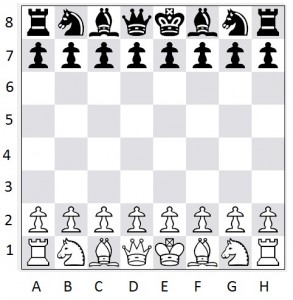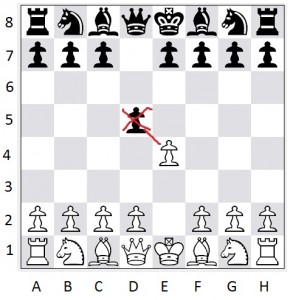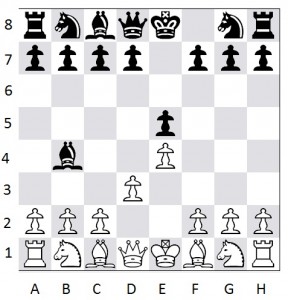Last time, we learned about an older form of notation called Descriptive Notation. It used to be the only thing players and books would use to notate moves made in a chess game. After the 1970’s, however, a new form of notation came around called Algebraic notation, which uses less characters and less writing in general.
Here are the symbols used in Algebraic notation:
R is for Rook.
B is for Bishop.
N is for Knight.
K is for King.
Q is for Queen.
x is the symbol for capturing a piece.
+ is the symbol for Check.
# is the symbol for Checkmate in algebraic notation.
= is the symbol for Pawn promotion. After the = will be the symbol for whichever piece you’ve turned the Pawn into (usually Q for Queen)
0-0 is for Castling on the kingside. (The Rook moves 2 spaces)
0-0-0 is for Castling on the queenside. (The Rook moves 3 spaces)
1-0 is the symbol for black resigning (1 win for white, 0 for black)
0-1 is the symbol for white resigning (0 wins for white, 1 for black)
1/2-1/2 is the symbol for a draw (1/2 win for both sides) either by draw offer, stalemate, 50 move rule (the 50 move rule says that if the opponents have both made 50 moves and not a single piece has been captured, then the game is a draw), or 3-move repetition (if the two opponents make the exact same moves 3 times consecutively, the game is a draw).
a-h are the files of the chess board.
1-8 are the ranks of the chess board.
Now that we have our legend of symbols, let’s talk about how to use them in
Algebraic Notation
To start with, since algebraic notation uses the lettered and numbered chess board that we’ve used in all blogs up to the one on descriptive notation, let’s look at the starting set-up:
You probably have already guessed that you won’t need to keep track of Kingside or Queenside like you did with algebraic. You also don’t need to worry about the starting positions for the purpose of labeling files, or counting spaces from each opponent. you’ll be using letters and numbers, making writing moves much quicker to see and comprehend (at least when playing on a board with numbers and letters, which most modern boards have).
You’ll also notice a couple things are missing from our legend. Algebraic notation does not use the Pawn symbol, nor does it use the – to notate movement. All moves just have what space they land on (unless there are 2 pieces of the same type that can get to same space, which we’ll discuss in a moment) by what piece is landing where. And if there is no piece listed, just an end space, it’s assumed it was a Pawn move.
So, going back to our same examples:
Those two Pawn moves would be written as
e4 c5
Becomes
exd5
Where we only care about the starting space because it’s a pawn.
This is now
Nxb7
Clearly, this is a much cleaner way to write this move than the descriptive version of
N(QB)xP(QN)
And finally our checkmate is
Qxf7#
But what if a piece other than a pawn is moving?
Comparing this Bishop Check move…
In Descriptive it would be: B-QN5 Notice that it’s a 5, not a 4 because in descriptive it goes from the prospective of the player making the move
In Algebraic it would be simply Bb4 Notice we don’t even bother putting the dash to notate movement. Again, it’s a much faster, cleaner way to write.
And what if two pieces can get to the same space?
Here, both white kNights can get to the same space. I’ve circled the one we’re going to move there.
In Descriptive this is: N(KB)-Q2 The Knight in line with the Kingside Bishop moves to the second space in the Queen file
In Algebraic this is: Nfd2 The Knight in the f file moves to d2.
If both pieces were even i the same file… let’s say the Knight on c4 was actually on f5 and you wanted to use that one to take the pawn at h4, you’d just write Nf5xh4. If there were no pawn there to take and you just moved there it would be Nf5h4.
So you can see why Algebraic notation is the more widely used notation now days. It’s fast, simple, and doesn’t involved any counting. It also makes mistakes in the notation almost obsolete where as with descriptive notation it’s not unlikely to see someone getting their kingside and queenside mixed up, or numbering from only their perspective and not their opponent’s.
You can use whichever version you like of course. There are people that still use descriptive notation (I actually still use it myself so I can re-play the games on any chess set – even those that aren’t lettered and numbered- and because I’ve been using it for so long it’s like a second language for me). Algebraic is what you’ll find in most modern books, though.








Very informative. Thank you verybmuch regarding the descriptive notation. It is featured in the opening of James Bond movie “From Russia with Love” where the orator states “Bishop ( or Queen) to King 7”. I knew the terminology was different to me. Not wanting to be found lacking, I kept rewinding the video to try to understand. Lol. And, Yes, I did have to count. Thank you for clearing things up. One example you may want to include for notation is the instance where two Rooks share the same file, but different ranks, such as RD1 and RD2 respectively, and one Rook moves further up the same file from its original rank.. Example Rook 2 to D8, R2D8. I discovered this rare instance of notation while playing the Chessmaster PC game. I’m just glad I understood it. Well, Thanks again! Ciao!